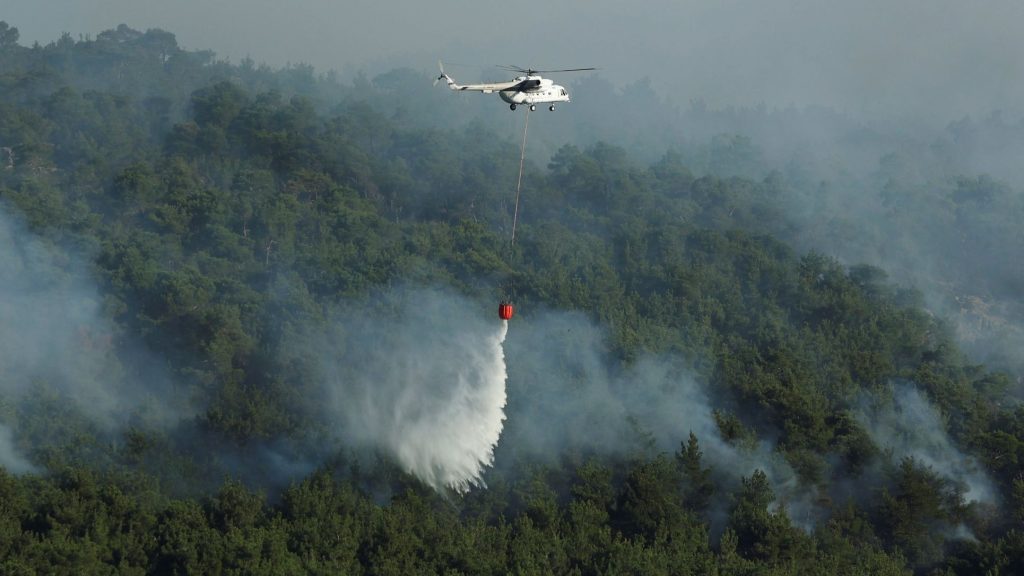
Wildfires are becoming more frequent and severe across the globe due to climate change and land use changes. In the UK, many people—used to looking out of a window at soggy scenery—will think that it won’t happen here.
But tell that to those who tackled the 2018 fires on Saddleworth Moor (near Manchester), at Winter Hill (near Blackburn), in Epping Forest (outskirts of east London), and at Glenshane Pass (in County Londonderry), or the hillside fire in Ceredigion that caused the Vale of Rheidol Railway to suspend services for two weeks.
Parts of the UK were extremely dry in 2018, but the year is not an outlier. Wildfires have continued to cause concern in the UK – for example, Marsden Moor (South Pennines) has experienced wildfires this year and last, causing huge damage, destroying nests and eggs of rare birds and affecting small creatures like frogs that could not escape. The area also contains carbon-rich peat, which can release greenhouse gases when burned.
Conditions conducive to wildfires are projected to become more common, threatening not only natural landscapes but also urban communities and infrastructure.
The Role of Climate Change
Climate change is a primary driver of the increased frequency and severity of wildfires in the UK. The UK’s climate is expected to experience milder, wetter winters that promote vegetation growth, followed by hotter, drier summers that increase the risk of this vegetation catching fire. Met Office modelling predicts a significant increase in the number of days with dangerous fire weather conditions, particularly in South East and Central England.
This changing climate pattern creates an environment where wildfires can start and spread more easily. Increased vegetation growth due to wetter winters provides more fuel for fires, while drier conditions in the summer make this fuel more flammable. This combination can lead to larger and more severe wildfires, similar to those seen in Mediterranean countries.
Land Use Changes and the Wildland-Urban Interface
Changes in land use are another critical factor contributing to the increased wildfire risk in the UK. Rural depopulation and the abandonment of agricultural land have led to unchecked vegetation growth, providing ample fuel for wildfires. Simultaneously, more people are moving to or holidaying near forested areas, increasing the likelihood of human-caused ignitions.
The wildland-urban interface (WUI), where urban areas meet wildlands, is particularly vulnerable. As more people live and visit these areas, the risk of fires affecting homes and infrastructure grows. In the UK, nearly all wildfires are started by human activities, whether through accidental ignitions like campfires and discarded cigarettes or intentional acts of arson.
Understanding the Human Factor in Wildfire Ignition
The overwhelming majority of wildfires are started by human activities, both accidental and deliberate. Accidental fires can be sparked by seemingly innocuous activities such as barbecues, fireworks, or even a discarded glass bottle that magnifies the sun’s rays. On the other hand, deliberate acts of arson are a significant concern, accounting for a substantial proportion of wildfires each year.
Addressing the human factor requires a multi-pronged approach. Public education and awareness campaigns are crucial to inform people about the risks associated with various activities and how to minimise them. Stricter regulations and enforcement regarding open fires and fireworks during high-risk periods can also be effective. Additionally, promoting responsible land management practices—such as clearing vegetation around homes and infrastructure—can create defensible spaces and reduce the risk of fire spread.
Strategies for Reducing Wildfire Risk
To address the growing wildfire threat, the UK must adopt a multi-faceted approach that includes better land management practices, public education, and improved wildfire response capabilities.
Early Detection: A Game-Changer in Wildfire Management
By integrating these sensors into a comprehensive early warning system, firefighters can be alerted within minutes of a fire’s ignition, enabling a swift response that can dramatically reduce the fire’s spread and potential damage. This not only protects lives and property but also minimises the long-term ecological impact of wildfires. Investing in early detection technologies is a proactive and effective approach to tackling the growing threat of wildfires in the UK.
While prevention is key, early detection of wildfires can be a game-changer in mitigating their impact. Emerging technologies, such as networks of AI-enabled cameras and gas sensors, offer promising solutions for rapidly identifying fires in their early stages. These sensors can detect the subtle signs of a wildfire, such as smoke particles or changes in air composition, long before the fire becomes visible to the human eye.
Conclusion
The UK faces a growing risk of wildfires similar to those in Spain, Portugal, and Greece due to the combined effects of climate change and land use changes. With the majority of wildfires caused by human activities, a comprehensive approach encompassing prevention, education, and improved response is necessary to reduce the number and impact of wildfires in the UK.
By implementing strategies such as better land management, public awareness campaigns, specialised wildfire response training, and investing in early detection technologies, the UK can work towards minimising the devastating effects of wildfires on both communities and the environment. Only through a concerted effort to address the root causes and enhance preparedness can the UK hope to avoid the kind of catastrophic wildfires that have plagued other European countries in recent years.
Carsten Brinkschulte is CEO and Co-founder of Dryad Networks. Dryad provides ultra-early detection of wildfires as well as health and growth-monitoring of forests using solar-powered gas sensors in a large-scale IoT sensor network.
Dryad aims to reduce unwanted wildfires, which cause up to 20% of global CO2 emissions and have a devastating impact on biodiversity. By 2030, Dryad aims to prevent 3.9m hectares of forest from burning, preventing 1.7bn tonnes of CO2 emissions.
Website: https://www.dryad.net/